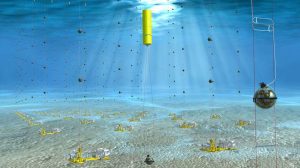A Dutch winding coil technique has become standard for placing detector lines for neutrino research in the Mediterranean Sea at kilometer depth. An overview article on the approach developed by NIOZ and Nikhef has now been published.
The article in the Journal of Instrumentation explains how vertical lines hundreds of meters long with delicate sensor spheres and cabling can be placed at great depths. This technique is needed to realize the KM3NeT neutrino detector, which is being built near France and Italy.

It will map traces of light that cause charged particles in the water after they have been activated by neutrinos. This makes it possible to study the fundamental properties of neutrinos as well as the sources in the universe from which the neutrinos originate.
The lines in the submarine detector forest have at regular distances so-called DOMs: glass spheres containing light-sensitive tubes that look in all directions. In the Italian ARCA system near the coast of Sicily, 230 lines over 700 meters long come at a depth of 3.5 kilometers. In the French part at a depth of 2.5 kilometers near Toulon off the coast, 115 ORCA lines are planned to be almost 200 meters long.
ARCA is particularly interesting for astrophysical research. ORCA is also suitable for particle studies.
Neutrinos are elementary particles created in nuclear processes. They do not feel the presence of matter particles and move with ease across a planet such as Earth. With a large detector like KM3NeT there is still some chance of catching such ghost particles.
The lines of the extended detector are held vertically by underwater floats. The connections of electronics are on the bottom in the sunken anchor. The whole is as light as possible, among other things by not using steel cables but wires from the Dyneema super fiber.
Art is to place hundreds of such lines precisely and safely on the seabed. Researchers from the Netherlands Institute for Sea Research (NIOZ) on Texel developed a coil, a so-called LOM, on which a line with bulbs and all connections and connections can be wound.
The procedure is described in detail in the new article. Also because we hope that the approach can be a solution for oceanographers, for example,’ says former Nikhef researcher Els de Wolf, who was involved with KM3NeT for a long time. Together with Hans van Haren of NIOZ, she was the driving force behind the new overview article.
The loaded LOM is sunk from a ship with a crane to the right position on the seabed in the depths. After arriving at the bottom, the coil loosens from the anchor, after which it moves upwards with the help of a float and in the meantime neatly unwinds the line of DOM balls through a sophisticated choreography. Also for the remote disconnection a special mechanism has been developed.
The first tests with that LOM unwinding system were already done in 2009 and 2010 off the coast of Greece and later also in Spain. In the meantime, a handful of lines have been placed and connected in the French part as well. The now still modest detector now provides the first measurement data.
KM3NeT should be further expanded rapidly in the coming years, and will then be the first neutron telescope of this size in the northern hemisphere. The experiment will then be an important counterpart to the IceCube detector in the ice of the South Pole.